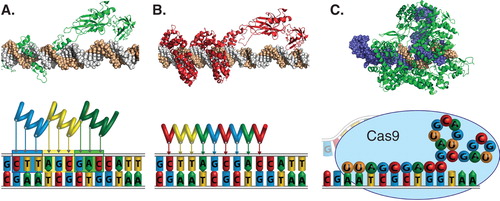Figures & data
Figure 1. Technologies for engineering programmable DNA-binding proteins, including (A) zinc finger proteins, (B) TALEs and (C) CRISPR/Cas9. (Top) Representative crystal structures of a (A) zinc finger protein (PDB 1P47) or (B) TALE (PDB 3UGM) fused to the p65 transcriptional activation domain (PDB 2RAM) or (C) Cas9 (green) bound to a gRNA (blue) and the corresponding DNA target site (brown) (PDB 4OO8). (Bottom) Zinc finger proteins and TALEs recognize their target sequences through non-covalent protein-DNA interactions with 3 bp or 1 bp per repeat domain, respectively. The CRISPR system consists of a complex of the gRNA and the Cas9 protein that recognizes its genomic target sequence by complementary base pairing of the gRNA (spheres) to the chromosomal DNA.

Table 1. Examples of therapeutic applications of engineered transcriptional activators.

